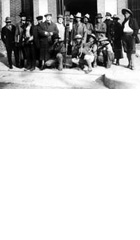
The Lost Reels of Pancho Villa 2003
Distributed by SubCine, 611 Broadway, Suite 616, New York, NY 10012; 212-253-6273
Produced by Universidad de Guadalajara, The Banff Centre, and Archivia Films, with additional support from FONCA/CONACULTA, The Fulbright Program, and Fundación Televisa
Directed by Gregorio Rocha
VHS, color, 49 min.
College - Adult
Film Studies, History, Media Studies
Date Entered: 06/04/2004
Reviewed by Jean O’Reilly, University of ConnecticutResearched, written, and produced by Gregorio Rocha, The Lost Reels of Pancho Villa is a film that isn’t quite sure what it wants to be. It is structured as a film historian’s ultimately fruitless search for the 1914 film, The Life of General Villa. That film, produced under an unusual contract between Villa and the Mutual Film Corporation, includes footage from the Mexican Revolution, specifically of Villa’s Constitutionalist Army attacking the Federal Army in Ojinaga. Rocha’s search for the 1914 film, which takes him to several countries where he unearths many other films about Villa (some of them once presumed lost, and some of them apparently containing clips taken from the 1914 film), would provide any budding film historian with a good example of just how frustrating and expensive historical research can be.
But Rocha’s quest for The Life of General Villa provides only the framework for a film that wants to explore several other topics, including early film practices in Hollywood, the changing image of Villa from around 1913 to 1930, and the unreliability of film and photographic images in historical research. Rocha introduces all of these topics, but he does so in a disorganized way that doesn’t make good use of his material. Rocha interviews several archivists and historians in his film, but he rarely explains who each speaker is, leaving us to wonder what sort of expertise each brings to bear upon the subject at hand. He uses voiceovers to present statements from historical figures and other film historians, but it isn’t always clear which voice belongs to which figure, or at what point we return to Rocha’s own narrative. Finally, the film is quite wordy, with much of it in Spanish with English subtitles, and so the English-speaking viewer spends much of his time concentrating on the subtitles and not enough time appreciating the many old photographs and rare film clips the film offers. The viewer’s experience of The Lost Reels of Pancho Villa is thus in some ways as frustrating as Rocha’s own search for The Life of General Villa.
Recommended for film students who are interested in pursuing careers as film historians and film archivists, I would also recommend this film for history students interested in the Mexican Revolution and Pancho Villa. Be warned, however, that the film assumes the viewer has a good working knowledge of Villa’s history and reputation, and of Mexican history in Villa’s era.